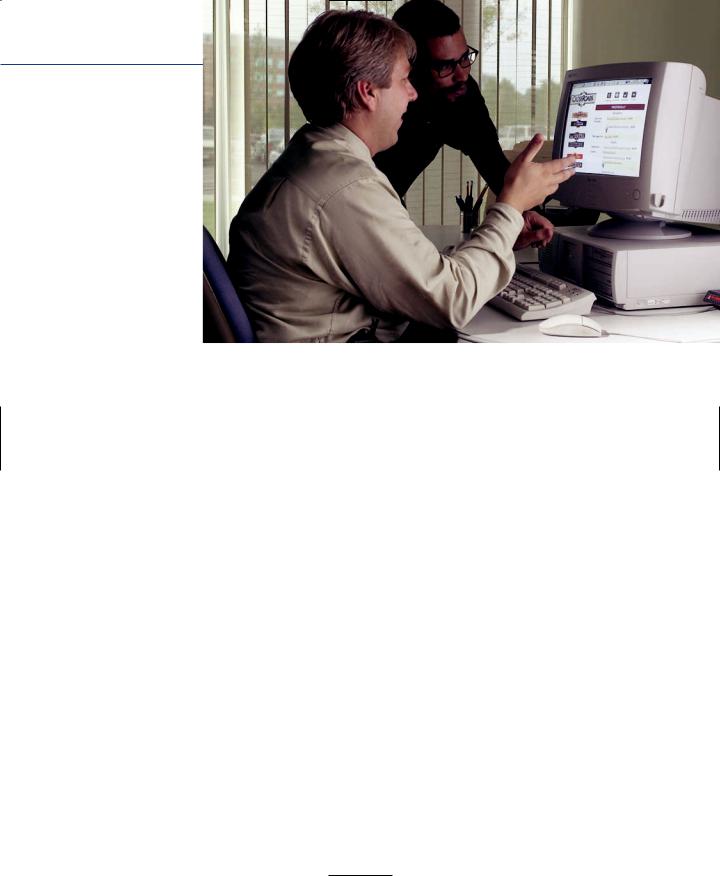
- •CONTENTS
- •PREFACE
- •Content—Benefits for Students
- •Content—Benefits for Instructors
- •Features of the Book for Students and Instructors
- •Supplementary Materials
- •Acknowledgments
- •What Is Hospitality Management?
- •The Manager’s Role in the Hospitality Industry
- •Why Study in a Hospitality Management Program?
- •Planning a Career
- •Employment as an Important Part of Your Education
- •Getting a Job
- •Employment at Graduation
- •The Outlook for Hospitality
- •Summary
- •Managing Change
- •Demand
- •Supply
- •Workforce Diversity
- •The Impact of Labor Scarcity
- •Summary
- •The Varied Field of Food Service
- •The Restaurant Business
- •The Dining Market and the Eating Market
- •Contemporary Popular-Priced Restaurants
- •Restaurants as Part of a Larger Business
- •Summary
- •Restaurant Operations
- •Making a Profit in Food Service Operations
- •Life in the Restaurant Business
- •Summary
- •Chain Restaurant Systems
- •Independent Restaurants
- •Franchised Restaurants
- •Summary
- •Competitive Conditions in Food Service
- •The Marketing Mix
- •Competition with Other Industries
- •Summary
- •Self-Operated Facilities
- •Managed-Services Companies
- •Business and Industry Food Service
- •College and University Food Service
- •Health Care Food Service
- •School and Community Food Service
- •Other Segments
- •Vending
- •Summary
- •Consumer Concerns
- •Food Service and the Environment
- •Technology
- •Summary
- •The Evolution of Lodging
- •Classifications of Hotel Properties
- •Types of Travelers
- •Anticipating Guest Needs in Providing Hospitality Service
- •Service, Service, Service
- •Summary
- •Major Functional Departments
- •The Rooms Side of the House
- •Hotel Food and Beverage Operations
- •Staff and Support Departments
- •Income and Expense Patterns and Control
- •Entry Ports and Careers
- •Summary
- •The Economics of the Hotel Business
- •Dimensions of the Hotel Investment Decision
- •Summary
- •The Conditions of Competition
- •The Marketing Mix in Lodging
- •Product in a Segmented Market
- •Price and Pricing Tactics
- •Place—and Places
- •Promotion: Marketing Communication
- •Summary
- •The Importance of Tourism
- •Travel Trends
- •The Economic Significance of Tourism
- •The United States as an International Tourist Attraction
- •Businesses Serving the Traveler
- •Noneconomic Effects of Tourism
- •Summary
- •Motives and Destinations
- •Mass-Market Tourism
- •Planned Play Environments
- •Casinos and Gaming
- •Urban Entertainment Centers
- •Temporary Attractions: Fairs and Festivals
- •Natural Environments
- •On a Lighter Note. . .
- •Summary
- •Management and Supervision
- •The Economizing Society
- •The Managerial Revolution
- •Management: A Dynamic Force in a Changing Industry
- •What Is Management?
- •Summary
- •Why Study Planning?
- •Planning in Organizations
- •Goal Setting
- •Planning in Operations
- •The Individual Worker as Planner
- •Long-Range Planning Tools
- •Summary
- •Authority: The Cement of Organizations
- •Departmentalization
- •Line and Staff
- •Issues in Organizing
- •Summary
- •Issues in Human-Resources Management
- •Fitting People to Jobs
- •Recruiting
- •Selection and Employment
- •Training
- •Retaining Employees
- •Staff Planning
- •Summary
- •The Importance of Control
- •Control and the “Cybernetic Loop”
- •Tools for Control
- •Summary
- •Leadership as Viewed by Social Scientists
- •Why People Follow
- •Leadership Theories
- •Communication
- •The Elements of Leading and Directing
- •Developing Your Own Leadership Style
- •Summary
- •A Study of Service
- •Rendering Personal Service
- •Managing the Service Transaction
- •How Companies Organize for Service
- •Summary
- •INDEX

634Chapter 20 Leadership and Directing in Hospitality Management
Consultation. Before a decision must be made, a manager can prevent hard feelings by consulting the workers who will be affected by that decision, as well as others who are knowledgeable in the area. Because of their familiarity with the activity in question, workers often see problems that managers may miss. Technical issues aside, this consultation often eases tensions associated with change and increases its chances of acceptance. As the previous section suggests, it is particularly important to consult workers who have the respect of their fellow workers and whose support may be crucial in gaining acceptance. Consultation should not be viewed as relinquishing management’s responsibility and authority for decisions based on the prerogatives of ownership or some other legally constituted authority.
Involvement. Managers often see a problem, develop a variety of solutions with the workers, and then present these alternatives to the employees themselves for their decision. If the first solution they choose does not work, further discussion and change are obviously in order. Often, however, the best way to gain acceptance of change is to involve those affected in the decision. Moreover, the solution to some problems probably belongs to and should be undertaken by the work group.
Thus, for instance, a group of servers may be asked to help management develop the best means for assigning sidework (housekeeping chores in the dining room such as stocking side stands or filling salt and pepper shakers). Management cannot really ask whether or not this work should be done; it must be done. The issue is how. Implicitly, if the solution offered does not work in practice, management must confer again with the affected workers and arrive at another solution.
Communication
For directions to be followed, they must be understood. The best-thought-out plan will fail if it is not communicated in a way that can be comprehended.
BARRIERS TO COMMUNICATION
Factors that inhibit clear communication pertain to the language we use, the differing backgrounds of the sender and the receiver, and the circumstances in which the communication takes place.
Semantic Barriers. Different people attach different meanings to words. The phrase “my work” may have quite a different meaning to a manager and to a busperson. To one, it refers to a life’s work; to the other, a part-time job after school. The word

Much of leadership involves effective communication skills. (Courtesy of Sodexho.)
management also conjures up different images for the manager and the person responsible for busing the dishes. To the manager, it may mean responsible execution of carefully studied company policy. By contrast, the busperson may think of the fact that “the boss docked my pay because I was late.” A communicator must, therefore, choose words that convey the meaning of the sender in such a way that the receiver understands that meaning. Loaded words with strong emotional meanings—“free enterprise,” “the system,” “right to work”—may do more to confuse the discussion than to clarify it.
Social Background. Social background is closely related to the problem just considered. The values of the middle-class American, the background typical among managers, carry certain assumptions that may not strike the expected response among some employees. A good example is the idea of ambition.
People brought up in middle-class families that encourage striving for success take ambition for granted. By contrast, people raised in poverty, who have acquired only limited schooling and who see themselves as never having had a chance, may look at ambition quite differently. When the middle-class manager assumes in his or her communication that the pot washer shares this enthusiasm for achievement, the manager may be in for some unpleasant surprises. It is important to consider exactly what point of view the other person is coming from.
Immediate Environment. The place where communication occurs can have an important effect on what gets understood. If a worker has been late, calling that person into the office to discuss the tardiness may be taken as a signal of a serious offense.
635

636Chapter 20 Leadership and Directing in Hospitality Management
If that signal is appropriate, fine, but if the tardiness is a first offense, it may be better to mention the matter to the worker privately in the immediate work area at a time when he or she is not busy.
On the other hand, a reprimand in front of other workers has quite a powerful negative impact. (There’s an old and good rule to remember: Praise in public, reprimand in private.) Similarly, discussion of complicated matters at the wrong time results in confusion. Let’s suppose the broiler operator asked you about a problem on his or her withholding tax form at a time when you couldn’t answer and you said, “I’ll get back to you later.” To try to answer that question in the middle of the rush hour when he or she is under considerable pressure will probably inhibit understanding and increase annoyance.
GATEWAYS TO COMMUNICATION
Listening. One of the most important acts in telling somebody something is—para- doxically—for you to listen. Communication is not a one-way street; it is an interchange. When you speak to people, they reply either in words or with body language—the way they hold themselves, the look on their face, a shrug. Listening and observing these body language cues will tell you a great deal about how your message has been received.
Empathy. Your ability to put yourself in the other person’s shoes in a conversation can be crucial to understanding and dealing with his or her reaction.
The Elements of Leading and Directing
Leading and directing are really continuous processes, but we can break them down into some key activities in which managers typically engage. In fact, the actions (or elements) we discuss here portray the diversity of leading and directing and demon-
strate how they can vary from situation to situation. They include (1) telling someone what to do, (2) providing information on how to do it, (3) seeing that he or she has learned how to do it, (4) making the performance of the work as appealing and comfortable as possible, and (5) conferring specific rewards or punishments for performance. Now, we will examine these elements of leading and directing in more detail.
1.Orders obviously tell someone to do something. They are acts of authority— authoritative directions.
2.Instruction provides information about some hospitality work-related activity.
3.Training involves guiding employees toward the mastery of often complex activities. Thus, a manager may give new employees a week’s training to qualify her or

The Elements of Leading and Directing |
637 |
him to begin work as a server. Properly executed, training involves not only telling and showing the trainees how to do the work but also evaluating later—for the benefit of both the trainees and the trainer—the quality of that learning. Trainees are permitted to do the work under supervision and to repeat the process until they achieve adequate mastery.
4.Motivating moves beyond ensuring that the worker knows how to do something; motivating makes the employee eager, or at least willing, to do the work. A manager who motivates employees tailors the whole array of inducements—pay, recognition and status, self-fulfillment—in a way appropriate to the needs and wants of each worker (within, of course, the limits of what is possible).
5.Sanctions may be either positive or negative, rewards or punishments.
Although motivation generally may be thought of as continuous and positive, individual acts of sanction can be either a raise or promotion, on one hand, or a fine or reprimand, on the other.
If a manager has done his or her job correctly, the employees will know what to do and how to do it, and they will have sufficient mastery of the work to accomplish it properly. Managers must continually respond to the individual needs and wants of workers to gain their willing commitment to work. Finally, managers are expected to recognize outstanding performance and, when necessary, to penalize those who do not perform adequately.
LEADERSHIP AND CHANGE
To this point, we have been discussing leadership and directing as two aspects of the same management function. Moreover, we have been discussing that function as a part of everyday ongoing activity in an operation. In an organizational crisis such as in a company that is losing money, however, the leadership needs of that organization emerge as critical.
Current research in the area of leadership suggests that managing change is one of the leading competencies that a leader must possess.4 In an organization that needs to make fundamental changes, the work of the leader has three basic elements:5
1.Establishing direction. Seeing where an organization needs to go and expressing that vision in a way that people can understand is vital. Moreover, the strategies for producing the necessary changes must be spelled out. Thus, the vision must be one that can be acted on effectively.
2.Aligning people. Getting the appropriate people in the organization not just involved but committed to achieving the new goals is a necessity. This involves lining

638 |
Chapter 20 Leadership and Directing in Hospitality Management |
up coalitions in the informal organization who will support the program of change.
Some might call this “selling” the vision.
3.Motivating and inspiring. In effect, this involves keeping people sold and keeping them moving in the right direction—often against obstacles that come from inside the organization, from people who are threatened by the needed changes.
We might consider the case of a new hotel manager who takes over an operation that has been completely demoralized.6 The hotel is at a very busy airport in a booming city. For its first few years, the hotel had both high occupancy and profits, but management neglected both the physical plant and the organization’s morale, that is, its people. Management turnover was high and employee turnover disastrously so. As new hotels were added in the area, the market became overbuilt at about the same time the city’s boom ended. Occupancy in the hotel dropped from over 85 percent to below 65 percent, then to less than 60 percent, and profit turned to loss. Bill Wayle was hired as food and beverage director, but the general manager (GM) quit two days after he arrived. The company asked Bill to take the GM’s job. He took over the operation but found almost immediately that the man he reported to was not prepared to make some key expenditures. Bill’s response was to decline the GM’s job unless he had the necessary support. He was given the modest financial support he requested, and so the turnaround could begin.
The first thing Bill did was to make some cosmetic changes in the lobby, replacing soiled and damaged furniture and light fixtures. The next thing he did was to announce a long-range improvement plan. He met regularly and frequently with department heads, attended department meetings, and spent a lot of his time moving around the hotel, talking with employees. Everywhere his message was the same: “We can’t fix everything at once, but we can improve our service now. Will you help?”
Bill reexamined operating procedures, pruned unnecessary payroll from politically powerful departments, and spent that money where it really affected service. He spent a lot of time on the phone selling his boss on the need to replace items such as wornout bedspreads and lampshades and to begin the long-term improvement plan he had already promised the employees.
Almost at once, employee turnover dropped, and people bought into Bill’s program to improve service now. As service improved and the property began to look less shabby, occupancy improved. In less than a year, the hotel was profitable again. With these results, it became easier to sell his company on the need for major investment.
We can look at Bill Wayle’s activities in the context of our description of leadership for change.
Establishing Direction. “Better service—now” was a vision everybody could be a part of. The few very visible changes Bill made helped employees feel that things
